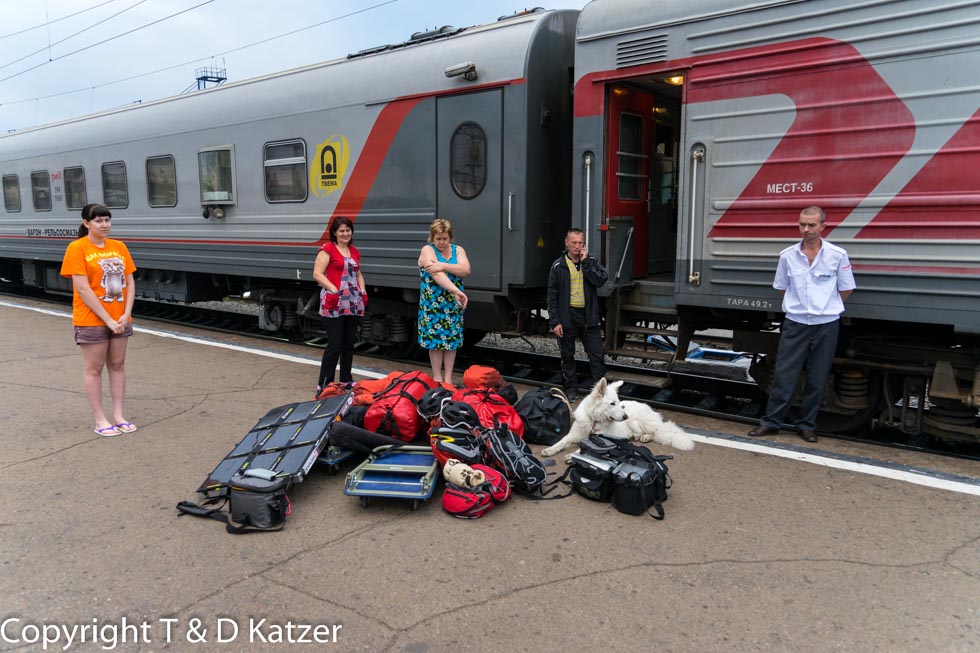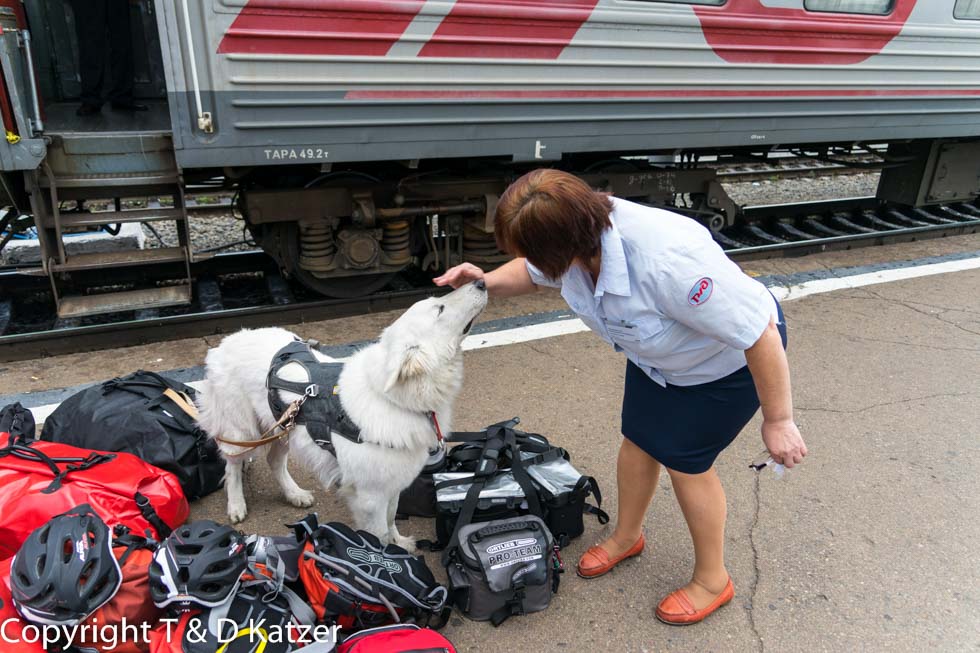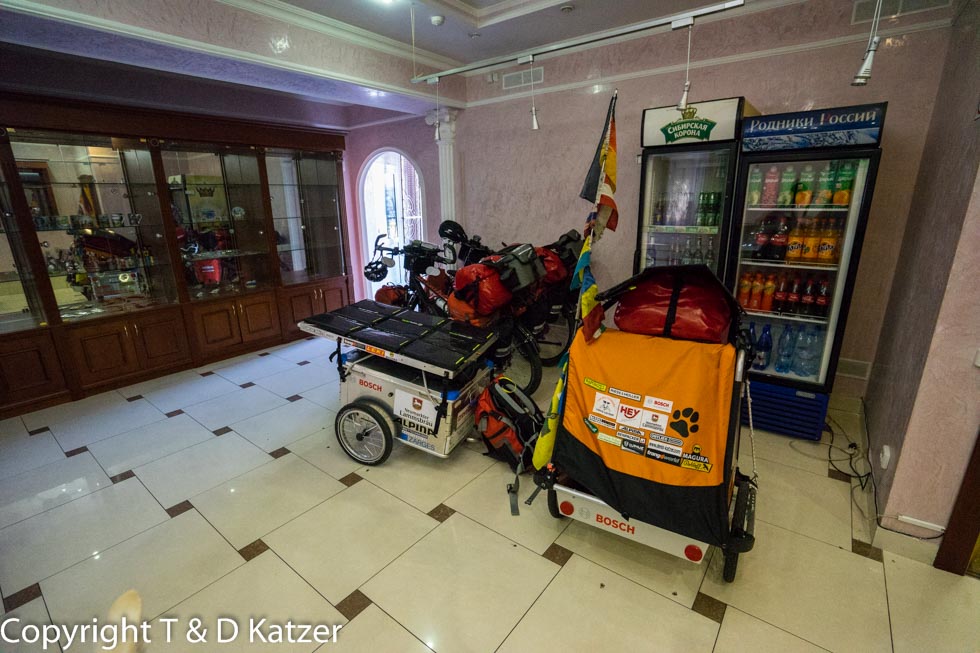
Arrival in Ulan Ude
N 51°49'23.3'' E 107°34'47.9''
Day: 14
Russia / Siberia
Location:
Ulan Ude
Daily kilometers:
1,493
Total kilometers:
8,055
Latitude N:
51°49’23.3”
Longitude E:
107°34’47.9”
(Photos of the diary entry can be found at the end of the text).
We leave the village of Selenga at midnight. “One more hour,” I say, climbing off my bunk bed and starting to clear the saddlebags and bags out of the compartments. It’s already been light outside for two hours, not because the sun is shining here forever, but because life on the train is still based on Moscow time. By now we have crossed five time zones and it is not actually midnight but 5:00 in the morning. We quickly carry the equipment into the narrow area in front of the train door so that we don’t have to stress about unloading it on arrival. “I’ll go to the luggage compartment and try to get the bikes out of there,” I say to Tanja. The train manager’s unfriendly assistant unlocks the door for me without comment. Obviously she hasn’t really digested the fact that I didn’t just saw our bikes in half. I nervously get the e-bikes out of the compartment, put the front wheels in and check them for damage. Apart from the broken mudguard and a few scratches, I can’t detect anything at the moment. Then the wagons jolt and the iron snake comes to a halt. A passenger is kind enough to help me unload the trailers and bikes while Tanja carries all the equipment onto the embankment two carriages further back with the helpful conductor Vladi. The entire unloading process runs completely smoothly. Much easier than we thought. As soon as the bikes are on the embankment, I give them another inspection. Countless gnats and mosquitoes bite us instantly. “Welcome to Siberia!” they seem to shout and have a great time tapping two new arrivals. A light drizzle seems to boost their energy. “All right!” calls Tanja, who is standing about 50 meters away from me next to a mountain of bags and guarding it with Ajaci. “It looks like not much is broken,” I reply, unpacking my tools and spare parts to repair the broken mudguard bracket. The train manager comes to see me again and wishes us a good journey. Does she have a guilty conscience because of the initial bad treatment? Could be. She says goodbye to her new friend Ajacerjuuu. Then the wagons jolt again. Some of the passengers and conductors wave to us. “Хорошая поездка!” (Have a good trip), they call out to us as the Trans-Siberian Railway disappears towards Vladivostok on the Sea of Japan. I pause my work for a moment and look after her. It is very likely that we will not have the opportunity to travel on this train again in this lifetime. Certainly not a sad moment because of the initial problems. Although, if you are traveling with normal luggage, this train ride is a very interesting and beautiful tour.
As soon as the 044 has disappeared, I put the bikes in the trailers, reattach the solar panels, click them onto the e-bikes and ride to Tanja to load the mountain of bags and equipment onto them. After just under an hour, we are ready to leave the station. “It’s fascinating that we managed to fit everything on the bikes,” says Tanja happily. “What are we going to do with the hand wagons?” I ask her. “No idea. Maybe some poor sod has a use for it.” “Good idea,” I reply. Because Ajaci can’t ride because of the hand pans that are now loaded in his trailer, I attach his leash to my hip belt. This is how we push our unusually heavy trestles out of the station. The people at this early hour look at us with wonder and curiosity. There is no doubt that our colorful appearance has something to do with birds of paradise. We place the bikes against the wall of the station building and think about where we can store the bikes. “Look over there. Maybe the restaurant owner is saving them for us for one day?” Tanja ponders. “There’s no harm in asking.” It doesn’t take long and Tanja comes back with her thumbs up. “No problem. We can pick them up tomorrow,” she says. Then we load Ajaci into his trailer, girth him up and get into the saddle. We stumble carefully over the broken sidewalk. Ajaci squeals with delight at finally being on the road. Again and again we ask about the Gastiniza (Gastiniza is a simple accommodation, but sometimes also the name for a real hotel) Many of the people living here look like Mongolians. They are Buryats, a Mongolian ethnic group of which around 500,000 live in this part of Siberia today. Apart from Buryat, they mainly speak Russian, which is why we can communicate to some extent. After about 3.5 kilometers, we arrive at our accommodation called Menshikov. “Looks quite nice,” says Tanja. “Yes, it’s very central. I think we’ll feel comfortable there for the next week,” I agree with her. We ring the bell and after a short electronic tone, the door opens. A friendly Russian woman was already waiting for us because Tanja had already booked this accommodation from Germany via an internet platform. “It’s crazy what you can do with today’s technology,” I say, because we are enjoying this luxury for the first time during our travels. We are allowed to put our bikes in the reception room. Then the lady shows us our room which is located directly under the roof. As there are only skylights, which can be opened with a bar, and no other windows, we can’t see outside. “It’s damn stuffy in here,” I realize. “I’ll be fine,” says Tanja. “Well, I don’t know, if it’s already this hot at 8 a.m., I think this little room will quickly turn into a sauna,” I reply. Once the bikes have been stowed and locked away in the cool lobby downstairs and we have carried all the equipment into the room, we explore the surrounding area. We want to know where we will spend the next few days, where we will recover from the exertions of the journey, acclimatize and write the stories we have experienced before we set off for Mongolia and begin our great e-bike journey.
The live coverage is supported by the companiesGesat GmbH: www.gesat.com and roda computer GmbH www.roda-computer.com The satellite telephone Explorer 300 from Gesat and the rugged notebook Pegasus RP9 from Roda are the pillars of the transmission.







